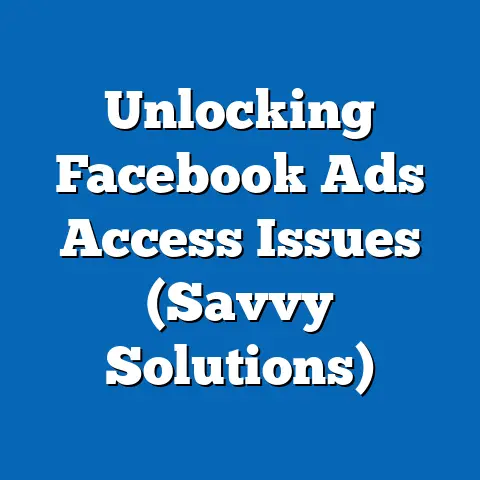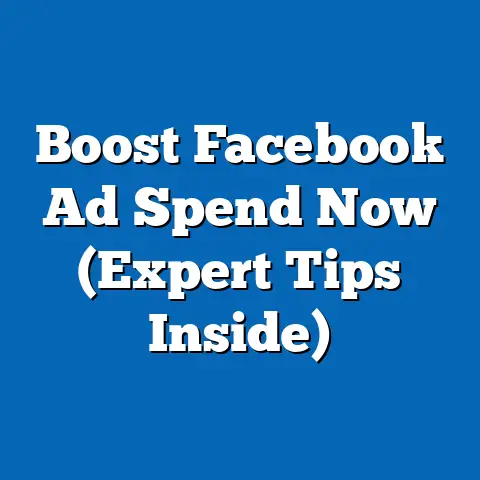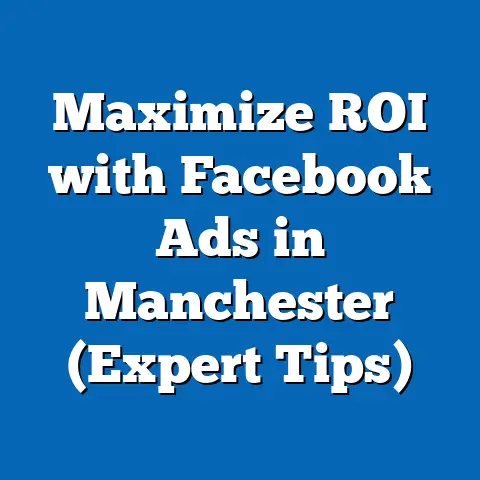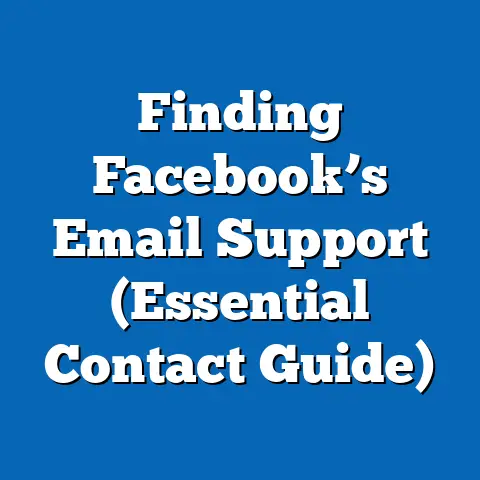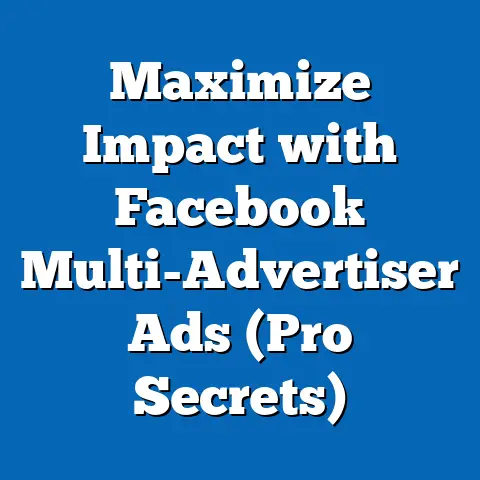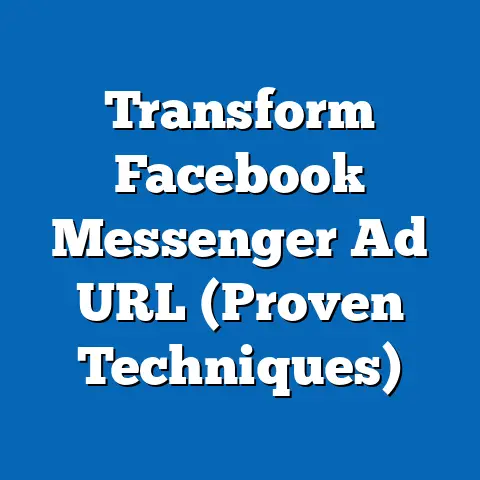Boost Engagement: Transform Facebook Ad Comments (Game-Changer)
I remember staring at the screen, utterly frustrated. My Facebook ad campaign, meticulously crafted and targeted, was…underwhelming. The ad itself looked decent, a visually appealing image with what I thought was compelling copy. But the engagement? Crickets. A few likes trickled in, but the comments section was a desolate wasteland. It felt like shouting into a void. This, I realized, was the “before” scene of many Facebook ads – a missed opportunity, a silent cry for attention in the bustling digital marketplace.
Then, I saw it. A competitor’s ad, similar in product and target audience, but the comment section was a vibrant hub of activity. People were asking questions, sharing their experiences, even tagging their friends. The brand was actively participating, responding to inquiries, and fostering a genuine conversation. This was the “after” scene, the potential realized. It was a lightbulb moment: Facebook ad comments weren’t just an afterthought; they were a crucial element of a successful campaign.
This article is about that transformation – how to move from the “before” to the “after,” how to unlock the hidden power of Facebook ad comments to boost engagement, build community, and ultimately, drive conversions.
Section 1: Understanding Facebook Ad Comments
Facebook ad comments are more than just digital scribbles under your carefully crafted advertisement. They represent direct engagement, a two-way street between your brand and your potential customers. They’re a window into what people think, feel, and say about your product or service. And in the context of social media, they wield significant power.
The Importance of Comments
Think of it this way: when you’re considering a purchase, what do you do? You probably read reviews, ask your friends for recommendations, and generally gather as much information as possible. Facebook ad comments function as a mini-review section, providing real-time feedback from real people.
Comments as Social Proof: This is arguably their most significant function. A vibrant comments section filled with positive feedback and genuine inquiries signals to potential customers that your product or service is legitimate, valuable, and worth considering. It’s the digital equivalent of a crowded restaurant – people assume it’s good because others are already there.
Comments as a Source of Information: Potential customers often use the comments section to ask specific questions about the product, shipping, or customer service. By actively responding to these inquiries, you not only provide valuable information but also demonstrate your commitment to customer satisfaction.
Comments as a Community Builder: A well-managed comments section can foster a sense of community around your brand. By encouraging conversation and responding thoughtfully, you can create a space where customers feel connected to each other and to your brand.
The Psychology of Engagement
Why are people more likely to engage with ads that have active comment sections? The answer lies in human psychology.
Fear of Missing Out (FOMO): When people see an ad with a lot of comments, they instinctively want to know what all the fuss is about. They’re afraid of missing out on something important or interesting.
Social Validation: People are more likely to trust and engage with something that has already been validated by others. A busy comments section provides that validation.
Curiosity: An active comments section piques curiosity. People want to see what others are saying, what questions are being asked, and how the brand is responding.
The Bandwagon Effect: The more people who are engaging with an ad, the more likely others are to join in. It’s the classic bandwagon effect – people want to be part of something popular and successful.
Takeaway: Facebook ad comments are a powerful tool for building trust, providing information, and fostering community. Understanding the psychology behind engagement is key to unlocking their full potential. My experience has shown me that ignoring the comment section is like ignoring a group of potential customers who are actively trying to engage with your brand. Don’t let that happen!
Section 2: The Current State of Facebook Ad Comments
While the potential of Facebook ad comments is immense, the reality is that many ads fall short of achieving meaningful engagement. The comment sections of countless ads are plagued by negativity, spam, or simply…silence.
Common Issues in Facebook Ad Comments
Negativity: This is perhaps the most daunting challenge. Negative comments can quickly derail an ad campaign, damaging your brand reputation and deterring potential customers. Common sources of negativity include:
- Customer complaints: Dissatisfied customers may use the comments section to voice their grievances.
- Product criticism: People may criticize the product’s features, quality, or price.
- Misleading advertising: If your ad is perceived as misleading or deceptive, you’re likely to attract negative comments.
Spam: Spam comments are not only annoying but can also damage your brand’s credibility. Common types of spam include:
- Irrelevant links: Comments that contain links to unrelated websites or products.
- Fake promotions: Comments that promote fake discounts or giveaways.
- Automated bots: Comments generated by automated bots that are designed to spread spam.
Silence: Perhaps the most disheartening issue is the absence of comments altogether. An ad with no comments can appear uninteresting or irrelevant, deterring potential customers from engaging. This can be due to various factors, including:
- Unengaging ad copy: If your ad copy is boring or irrelevant, people are unlikely to comment.
- Poor targeting: If your ad is not targeted to the right audience, it may not resonate with them.
- Lack of call to action: If your ad doesn’t explicitly encourage comments, people may not think to leave one.
The Engagement Gap: Statistics and Real-World Examples
While Facebook doesn’t publicly release specific statistics on ad comment engagement, industry reports and my own observations suggest a significant engagement gap.
- Low Engagement Rates: Many ads achieve only a small percentage of engagement compared to their reach, indicating a missed opportunity to connect with potential customers.
- High Percentage of Ads with Zero Comments: A significant number of Facebook ads receive no comments at all, suggesting a failure to spark conversation.
Real-World Examples:
Ad with Poor Engagement: I recently saw an ad for a new brand of protein powder. The ad featured a generic image of a muscular man and a bland description of the product’s benefits. The comment section was filled with spam and irrelevant links, with no responses from the brand. This ad failed to generate any meaningful conversation and likely deterred potential customers.
Ad with Excellent Engagement: On the other hand, I encountered an ad for a local coffee shop that featured a heartwarming video of the owner sharing their story. The ad copy asked viewers to share their favorite coffee memory. The comment section was buzzing with activity, with people sharing their personal stories and tagging their friends. The coffee shop actively responded to comments, creating a sense of community and driving traffic to their store.
Takeaway: The current state of Facebook ad comments is a mixed bag. While some ads excel at generating engagement, many others struggle with negativity, spam, or silence. Understanding these challenges is the first step towards transforming your ad comments into a valuable asset. From my own experience, I’ve learned that addressing negative comments promptly and proactively can turn a potential crisis into an opportunity to demonstrate your brand’s commitment to customer satisfaction.
Section 3: Strategies for Transforming Comments
Now, let’s dive into the actionable strategies you can use to transform your Facebook ad comments from a wasteland into a thriving community hub.
3.1 Crafting Engaging Ad Copy
Your ad copy is the foundation of your engagement strategy. It’s the first thing people see, and it sets the tone for the entire conversation.
The Power of Storytelling: People are naturally drawn to stories. Instead of simply listing the features and benefits of your product, try telling a story that resonates with your audience.
- Example: Instead of saying “Our new skincare cream reduces wrinkles,” try “After years of struggling with dry, flaky skin, Sarah finally found a solution with our new skincare cream. Now, she feels confident and radiant, and her wrinkles have visibly diminished.”
Creating Relatable Content: Your ad copy should speak directly to the needs, desires, and pain points of your target audience.
- Understand your audience: Conduct thorough research to understand their demographics, interests, and motivations.
- Use their language: Use the same language and tone that your audience uses.
- Address their concerns: Acknowledge their concerns and offer solutions.
Example: If you’re targeting busy moms, your ad copy might say, “Tired of spending hours in the kitchen? Our new meal delivery service makes healthy eating easy and convenient for busy moms.”
Specific Tips:
- Keep it concise: People have short attention spans, so get to the point quickly.
- Use strong verbs: Use verbs that are active and engaging.
- Highlight benefits, not just features: Focus on what your product can do for your audience.
- Use emojis sparingly: Emojis can add personality, but don’t overdo it.
My Personal Experience: I once ran an ad campaign for a local bookstore. Instead of simply promoting their latest releases, I created a series of ads that shared heartwarming stories about the bookstore’s impact on the community. One ad featured a story about a young girl who discovered her love of reading at the bookstore. The ad copy asked viewers to share their own favorite bookstore memories. The response was overwhelming, with people sharing their personal stories and tagging their friends. The campaign not only drove traffic to the bookstore but also created a strong sense of community.
3.2 Encouraging Interaction
Once you’ve crafted engaging ad copy, the next step is to actively encourage users to comment.
Ask Questions: This is one of the simplest and most effective ways to spark conversation.
- Open-ended questions: Ask questions that require more than a simple “yes” or “no” answer.
- Relatable questions: Ask questions that relate to your audience’s interests and experiences.
- Controversial questions: Be careful with this one, but sometimes a slightly controversial question can generate a lot of discussion.
Example: “What’s your favorite way to unwind after a long day?” or “What’s the best book you’ve read this year?”
Run Polls: Facebook polls are a great way to get quick feedback and generate engagement.
- Keep it simple: Make the poll easy to understand and participate in.
- Offer interesting options: Provide options that are relevant to your audience’s interests.
- Promote the poll: Share the poll on your page and in relevant groups.
Example: “What’s your favorite type of pizza?” or “What’s your preferred method of exercise?”
Use Calls to Action (CTAs): Explicitly tell people what you want them to do.
- “Share your thoughts in the comments below.”
- “Tag a friend who would love this.”
- “Let us know what you think!”
The Role of Visual Elements: Images and videos can be incredibly powerful tools for sparking conversations.
- Eye-catching visuals: Use high-quality images and videos that grab attention.
- Relatable visuals: Use visuals that resonate with your target audience.
- Interactive visuals: Use visuals that encourage interaction, such as asking people to guess what’s in the image or video.
Example: A video of a chef preparing a delicious meal can encourage people to share their favorite recipes or cooking tips.
Takeaway: Crafting engaging ad copy and actively encouraging interaction are essential for transforming your Facebook ad comments. By using storytelling, relatable content, questions, polls, and strong calls to action, you can spark conversation and build a thriving community around your brand. I’ve found that experimenting with different types of CTAs can significantly impact engagement rates. Don’t be afraid to try new things!
3.3 Building a Community
Building a community around your Facebook ads is the ultimate goal. It’s about creating a space where customers feel connected to each other and to your brand.
Creating a Sense of Belonging:
- Use inclusive language: Use language that makes people feel welcome and valued.
- Acknowledge contributions: Acknowledge and appreciate the contributions of your community members.
- Create a shared identity: Create a sense of shared identity by using hashtags, themes, or other elements that unite your community.
Example: A fitness brand might use the hashtag #FitFam to create a sense of community among its customers.
Responding to Comments Authentically:
- Be genuine: Be yourself and let your personality shine through.
- Be helpful: Provide helpful and informative responses to questions and comments.
- Be empathetic: Show empathy and understanding when responding to negative comments.
Creating a Safe and Positive Environment:
- Moderate comments: Monitor the comments section and remove any inappropriate or offensive content.
- Set clear guidelines: Establish clear guidelines for community behavior and enforce them consistently.
- Promote positive interactions: Encourage positive interactions and discourage negativity.
Examples of Brands Building Communities:
- Sephora: Sephora has built a thriving community around its Facebook ads by sharing makeup tips, hosting live Q&A sessions with beauty experts, and encouraging customers to share their own makeup looks.
- Nike: Nike has built a strong community around its Facebook ads by sharing inspiring stories, promoting its fitness apps, and encouraging customers to participate in fitness challenges.
- Lululemon: Lululemon has built a loyal community around its Facebook ads by sharing yoga tips, promoting its activewear, and hosting local events.
My Secret Weapon: I’ve always found that running contests and giveaways related to my ads not only boosts engagement but also fosters a sense of community. People love free stuff, and it encourages them to participate and interact with your brand. Just make sure the contest is relevant to your product or service and that the rules are clear and easy to understand.
Takeaway: Building a community around your Facebook ads is a long-term investment that can pay off in increased engagement, brand loyalty, and ultimately, conversions. By creating a sense of belonging, responding to comments authentically, and creating a safe and positive environment, you can transform your ad comments into a valuable asset.
Section 4: Responding to Comments Effectively
Responding to comments effectively is just as important as generating them in the first place. How you respond can either strengthen your brand’s image or damage it irreparably.
The Significance of Timely Responses
In the fast-paced world of social media, speed is of the essence. People expect quick responses, and a delayed response can be perceived as a lack of interest or concern.
- Aim for a response within 24 hours: This is a general guideline, but try to respond even sooner if possible.
- Prioritize negative comments: Address negative comments as quickly as possible to prevent them from escalating.
- Set expectations: If you can’t respond immediately, let people know when they can expect a response.
Crafting Thoughtful Replies
Your responses should be more than just generic acknowledgments. They should be thoughtful, personalized, and aimed at encouraging further engagement.
- Acknowledge the commenter’s point: Show that you’ve actually read and understood their comment.
- Provide helpful information: Offer helpful information or resources that address their concerns.
- Ask follow-up questions: Encourage further conversation by asking follow-up questions.
- Thank them for their feedback: Show your appreciation for their input.
Personalized Responses vs. Generic Replies
Personalized responses are far more effective than generic replies. They show that you care about the individual commenter and are willing to go the extra mile to address their needs.
- Use the commenter’s name: Address them by name to make the response more personal.
- Refer to their specific comment: Reference their specific comment to show that you’ve actually read it.
- Tailor your response to their needs: Customize your response to address their specific concerns.
Example:
Generic Reply: “Thank you for your feedback. We appreciate your input.”
Personalized Reply: “Hi [Commenter Name], thanks for sharing your thoughts on our new product. I understand your concern about [specific issue]. We’re working on a solution and will keep you updated. In the meantime, you can try [specific suggestion].”
Handling Negative Comments:
- Stay calm and professional: Don’t get defensive or argumentative.
- Acknowledge their concerns: Show that you understand their frustration.
- Offer a solution: If possible, offer a solution to their problem.
- Take the conversation offline: If the issue is complex, offer to take the conversation offline to resolve it privately.
My Biggest Mistake (and How I Learned From It): Early in my career, I made the mistake of deleting a negative comment on a Facebook ad. I thought I was protecting my brand, but it backfired spectacularly. The commenter noticed, took a screenshot, and shared it on their own social media channels, accusing me of censorship. It was a PR nightmare. I learned that transparency and honesty are always the best policy. Now, I always address negative comments head-on, offering solutions and demonstrating my commitment to customer satisfaction.
Takeaway: Responding to comments effectively is crucial for building trust, fostering community, and managing your brand’s reputation. By being timely, thoughtful, and personalized, you can transform negative comments into opportunities to showcase your commitment to customer satisfaction.
Section 5: Leveraging User-Generated Content
User-generated content (UGC) is any content created by your customers, rather than your brand. It can include photos, videos, reviews, testimonials, and social media posts. Leveraging UGC in your Facebook ad comments can be a game-changer.
What is User-Generated Content (UGC)?
UGC is authentic, relatable, and often more persuasive than traditional advertising. It’s a form of social proof that can significantly boost engagement and drive conversions.
Why UGC Matters in Facebook Ad Comments
- Authenticity: UGC is perceived as more authentic and trustworthy than brand-created content.
- Relatability: UGC is created by real people who have similar experiences and interests as your target audience.
- Cost-effectiveness: UGC is often free or low-cost, making it a cost-effective way to boost engagement.
- Increased engagement: UGC can spark conversation and encourage other users to share their own experiences.
Strategies for Encouraging UGC
- Run contests and giveaways: Encourage users to submit their own content for a chance to win a prize.
- Ask for testimonials: Request testimonials from satisfied customers.
- Create a hashtag: Encourage users to share their content using a specific hashtag.
- Feature UGC in your ads: Showcase user-generated content in your Facebook ads.
Example: A clothing brand might run a contest asking users to share photos of themselves wearing their clothes using a specific hashtag. The brand could then feature the best photos in its Facebook ads.
Case Studies of Brands Leveraging UGC
- GoPro: GoPro is a master of UGC. The brand encourages its customers to share their adventure videos using the hashtag #GoPro. GoPro then features the best videos on its Facebook page and in its ads.
- Starbucks: Starbucks encourages its customers to share photos of their coffee creations using the hashtag #Starbucks. The brand then features the best photos on its Facebook page and in its ads.
- Airbnb: Airbnb encourages its customers to share photos and stories of their travel experiences using the hashtag #Airbnb. The brand then features the best photos and stories on its Facebook page and in its ads.
My Most Successful UGC Campaign: I ran a campaign for a local bakery that encouraged customers to share photos of their favorite baked goods using the hashtag #SweetTreats. The response was incredible. We received hundreds of photos, and the engagement on our Facebook ads skyrocketed. We even created a “Customer’s Choice” menu item based on the most popular photo.
Takeaway: Leveraging user-generated content in your Facebook ad comments is a powerful way to boost engagement, build trust, and drive conversions. By encouraging users to share their own experiences and content, you can create a more authentic and relatable brand image.
Section 6: Analyzing and Adapting Engagement Strategies
Engagement strategies aren’t one-size-fits-all. What works for one brand might not work for another. That’s why it’s crucial to analyze your results and adapt your strategies accordingly.
Tools and Metrics for Measuring Engagement
Facebook provides a wealth of data that you can use to measure the effectiveness of your engagement strategies.
- Reach: The number of people who saw your ad.
- Impressions: The number of times your ad was displayed.
- Engagement Rate: The percentage of people who engaged with your ad (likes, comments, shares).
- Click-Through Rate (CTR): The percentage of people who clicked on your ad.
- Cost Per Click (CPC): The average cost of each click on your ad.
- Cost Per Engagement (CPE): The average cost of each engagement (like, comment, share).
Facebook Analytics: Use Facebook Analytics to track user behavior on your website and app. This data can help you understand how people are interacting with your brand beyond Facebook.
Analyzing Comment Sentiment
Understanding the sentiment of your comments is crucial for managing your brand’s reputation and adapting your engagement strategies.
- Manual Analysis: Read through your comments and identify the overall sentiment (positive, negative, neutral).
- Sentiment Analysis Tools: Use sentiment analysis tools to automatically analyze the sentiment of your comments. These tools can help you identify trends and patterns in your feedback.
Adapting Strategies Based on Data
- Test different ad copy: Experiment with different headlines, descriptions, and calls to action to see what resonates best with your audience.
- Try different visuals: Use different images and videos to see which ones generate the most engagement.
- Target different audiences: Experiment with different targeting options to see which audiences are most receptive to your ads.
- Adjust your bidding strategy: Adjust your bidding strategy to optimize for engagement or conversions.
The Importance of Ongoing Experimentation:
The Facebook advertising landscape is constantly evolving. New features are introduced, algorithms change, and user behavior shifts. That’s why it’s essential to continuously experiment with different strategies and tactics to stay ahead of the curve.
My Biggest Learning: I used to think that once I found a winning formula, I could just stick with it. But I quickly learned that what works today might not work tomorrow. Now, I dedicate a significant portion of my time to experimenting with new strategies and tactics. I’m constantly testing different ad copy, visuals, targeting options, and bidding strategies. This ongoing experimentation has allowed me to stay ahead of the curve and consistently improve my results.
Takeaway: Analyzing and adapting your engagement strategies is an ongoing process. By tracking your metrics, analyzing comment sentiment, and experimenting with different strategies, you can continuously improve your results and maximize the return on your Facebook advertising investment.
Conclusion: The Future of Facebook Ad Comments
The future of Facebook ad comments is bright. As social media continues to evolve, comments will become even more important as a way for brands to connect with their customers, build community, and drive conversions.
Reflecting on the Transformative Potential
A well-managed comments section can transform your Facebook ads from a one-way broadcast into a two-way conversation. It can turn potential customers into loyal brand advocates. It can create a sense of community and belonging.
Summarizing Key Strategies
- Craft engaging ad copy: Tell stories, create relatable content, and use strong calls to action.
- Encourage interaction: Ask questions, run polls, and use eye-catching visuals.
- Build a community: Create a sense of belonging, respond authentically, and create a safe and positive environment.
- Respond to comments effectively: Be timely, thoughtful, and personalized.
- Leverage user-generated content: Encourage users to share their own experiences and content.
- Analyze and adapt engagement strategies: Track your metrics, analyze comment sentiment, and experiment with different strategies.
A Powerful Call to Action
I urge you to rethink your approach to Facebook ads and the comments they generate. Don’t treat your comments section as an afterthought. Treat it as a valuable asset that can help you achieve your business goals.
Start today. Review your existing Facebook ads and identify opportunities to improve your engagement strategies. Experiment with different tactics and track your results. Be patient, persistent, and willing to learn.
The transformation from a silent, neglected comments section to a vibrant, engaging community hub is within your reach. Embrace the power of Facebook ad comments, and watch your engagement soar. Remember my initial frustration? Now, I see the comment section as an opportunity, a chance to connect with my audience on a deeper level, and a powerful tool for driving business growth. And you can too!

